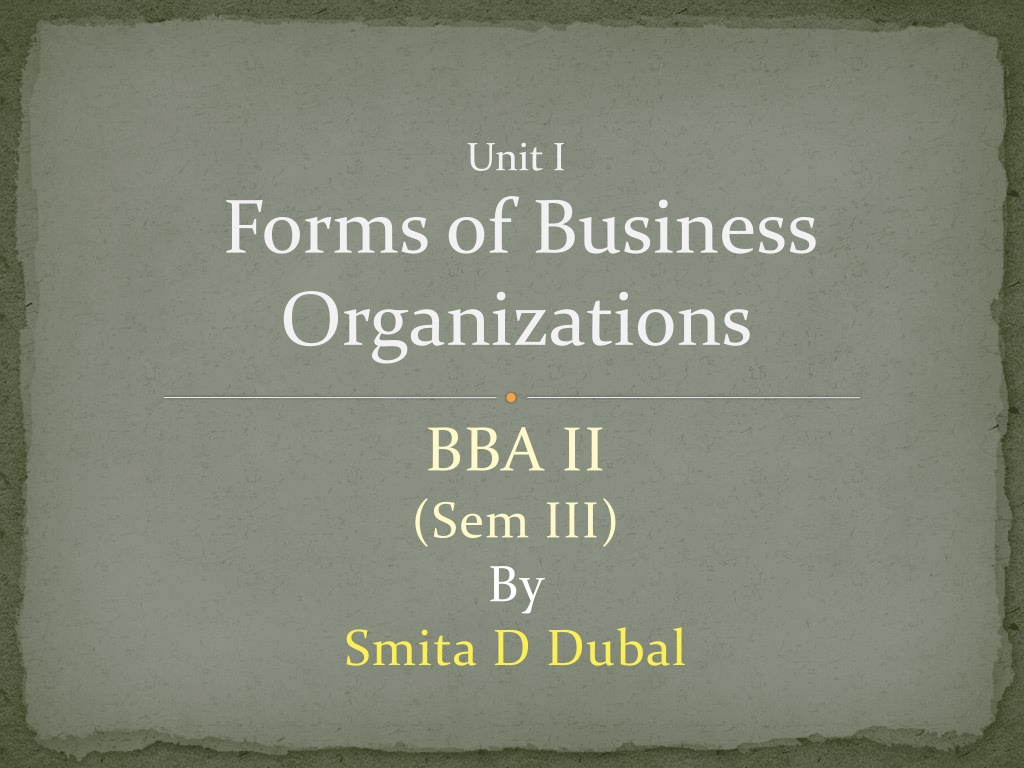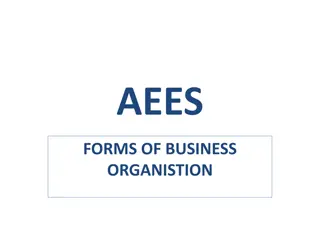Understanding Business Organizations: Forms, Characteristics, and Objectives
Business organizations play a crucial role in the economy. They encompass various forms such as sole proprietorship, partnership, company, etc., each with its own set of characteristics and objectives. Businesses operate with the primary motive of earning profit, while also focusing on customer satisfaction and continuous improvement. Risk and uncertainties are inherent in business activities, but certain factors can be controlled. Understanding the concept and importance of different forms of business organizations is essential for aspiring entrepreneurs and business professionals.
Download Presentation

Please find below an Image/Link to download the presentation.
The content on the website is provided AS IS for your information and personal use only. It may not be sold, licensed, or shared on other websites without obtaining consent from the author. Download presentation by click this link. If you encounter any issues during the download, it is possible that the publisher has removed the file from their server.
E N D
Presentation Transcript
Unit I Forms of Business Organizations BBA II (Sem III) By Smita D Dubal
Contents Forms of business organization: 1. Meaning and definition ,Types of business 2. Characteristics of Business Organization 3. Features of sole proprietorship, Joint Hindu Family & co-operative society. 4. Features& types of partnership & joint stock company. 5. One person company, Producer Company and non banking financial company as per companies act 2013.
Business Meaning Business is any activity which is carried out to make or earn profit.
Business Definition A business (entity) is an organization or any other entity engaged in commercial, professional, charitable or industrial activities. It can be a for-profit entity or a not-for-profit entity and may or may not have a separate existence from the people/person controlling it. A business (activity) is a commercial activity which involves providing goods or services with a primary motive of earning profits
Concept Of Business The business concept is the fundamental idea behind the business. The business model, plan, vision, and mission are developed based on this concept. Uber, for example, was started on the concept of aggregating taxi drivers and providing their services on demand under one brand. Every other business strategy was developed based on this concept.
Objective Of The Business The business objective is what makes the business go on and conduct its activities in a long run. According to the traditional concept, business exists only to earn profits by providing the goods and services to the customers. According to the modern concept, the underlying objective of every business is customer satisfaction as this is what results in most profits. If the customer is satisfied, business excels.
Important Characteristics of a Business 1. Economic activity 2. Buying and Selling Buying and Selling Business 3. Continuous process 4. Profit Motive Continuous process Profit Motive
Important Characteristics of a Business 5. Risk and Uncertainties Predictable factors are controllable to some extent, such as: a) Taxes b) Change in the volume of expected sales c) Cost of supplies and equipment d) Overhead costs e) Salaries f) Cost of goods and services offered
Important Characteristics of a Business Unpredictable factors include: a) Changes in trends and tastes of customers. b) Impact of the local economy on customer base. c) Any unexpected action taken by your competitors. The calculation and management of the risk is vital to ensure the success of a business firm. Insurance and Risk management helps in minimizing the risk associated with the business
Important Characteristics of a Business 6. Creative and Dynamic 7. Customer satisfaction Creative and Dynamic Customer satisfaction 8. Social Activity 9. Optimum utilization of resources: Social Activity Optimum utilisation of resources
Important Characteristics of a Business 10. Government control Some important acts framed by the government include: i. The Competition Act, 2002 ii. Foreign Exchange Management Act, 1999 iii. The Environment Act, 1986 iv. Indian Companies Act, 1956 v. Consumer protection Act
Business Organisation Business Organization is one which performs commercial activities for earning the profit. It provides goods & services to customers as per their needs. These have a well-defined structure and works according to that. The size of the business organization differs as per their objectives. It aims at achieving a healthy relationship between employees, tasks, and various resources so that they can work together to achieve common goals.
Forms of Business Organisation Meaning A business enterprise is an institutional arrangement to form any business activity.
Sole Proprietorship Sole Proprietorship It is a one-man business and is owned by a single person. There is only one person to manage and run the business. It is very easy to set up and requires less cost among all. It is suitable for small businesses setup. It avoids the cost of creating a corporation or partnership. Here the owner faces unlimited liability. Creditors can take personal assets of the owner if the business does not pay debts.
Joint Hindu Family Business It is the different form of business which exists only in India. It is not legal in the rest of the world. It is run and governed by the Hindu law. The eldest member of the family is head of a business. The head of the business is called Karta . He manages all the finances of the business. Family members are the co-partners of business.
Partnership It is a business which is owned by two or more persons. They together contribute resources for the business. The profit of the business is divided by these partners. Generally, in partnership, all partners have unlimited liability. They all are equally responsible for business debts
Co-Operative Society It is a business which is run by a group of persons. It is operated by them for their mutual benefit. These persons are called members of the business. It may be corporate or in- corporated. Its members join the business by their own choice. Membership is open for all who have common goals. Minimum 10 members are required for this business. Profit of the business is divided among its members.
Joint-Stock Company It is a business which is owned together by its shareholders. Shareholders are the one which buys some stock in the company. Profit is provided to them as per their shareholding These persons join the company as per their choice. Finance of the company is provided by shareholders. These shareholders can transfer their ownership to another person.
Company It is a business which sells goods for earning money. It is run by two or more persons together. The profit is also divided by these persons. All its members are responsible for its debt and operation. There are certain which governs the working of companies. Every company has its own mission & objectives. All its members work hard to achieve these goals.
Characteristics of Business Characteristics of Business Organisation Organisation Efficient Usage Of Resources Better Communication Easy Acquiring Better Administration Increase Productivity & Job Satisfaction overall productivity at lower costs. Better Working Relationship
Sole Proprietorship Sole proprietorship means a business owned, financed and controlled by a single person who is recipient of all profit and bearer of all risks. It is SUITABLE IN AREAS OF PERSONALISED SERVICE like beauty parlor, hair cutting saloons & small scale activities like retail shops.
Sole Proprietorship Features 1. Single ownership 2. Control 3. No separate legal entity 4. Unlimited liability 5. No legal formalities 6. Sole risk bearer and profit recipient
Sole Proprietorship Merits 1. Easy to start and close 2. Quick decision making 3. Sense of accomplishment 4. Unlimited liability 5. No legal formalities. 6. Sole risk bearer and profit recipient
Sole Proprietorship LIMITATIONS 1. Limited financial resources 2. Limited Managerial ability 3. Unlimited liability 4. Uncertain life 5. Limited scope for expansion
Sole Proprietorship SUITABILITY: Sole trader ship is suitable- Where the personal attention to customer is required as in tailoring, beauty parlor. Where goods are unstandardized like artistic jewellery. Where modest capital and limited managerial skills are required as in case of retail store Business where risk is not extensive i.e. lesser fluctuation in price and demand i.e. stationery shop.
JOINT HINDU FAMILY BUSINESS It is owned by the members of undivided joint Hindu family and managed by the eldest member of the family known as KARTA. It is governed by the provisions of Hindu law. The basis of membership is birth in a particular family
JOINT HINDU FAMILY BUSINESS FEATURES 1. Formation 2. Membership by birth There are two systems which govern membership Dayabhaga System- It prevails in west Bengal and allows both male and female member to co-parcencers. Mitakshara System- It prevails all over India except West Bengal and allows only male members to be coparceners 3. Liability 4. Continuity 5. Minor members
JOINT HINDU FAMILY BUSINESS MERITS 1. Effective control 2. Continued business existence 3. Limited liability 4. Secrecy 5. Loyalty and Co-operation
JOINT HINDU FAMILY BUSINESS LIMITATION 1. Limited capital 2. Unlimited liability of karta 3. Dominance of karta 4. Hasty decisions 5. Limited managerial skills of karta
PARTNERSHIP Meaning: Partnership is a voluntary association of two or more persons who agree to carry on some business jointly and share its profits and losses.
PARTNERSHIP FEATURES 1. Two or more persons 2. Agreement 3. Lawful business 4. Decision making & control 5. Unlimited liability 6. Mutual Agency 7. Lack of continuity
PARTNERSHIP MERITS 1. Ease of formation & closure 2. Larger financial resources 3. Balanced Decisions 4. Sharing of Risks 5. Secrecy
PARTNERSHIP LIMITATIONS 1. Limited resources 2. Unlimited liability 3. Lack of continuity 4. Lack of public confidence
PARTNERSHIP TYPES OF PARTNERS 1. General / Active Partner 2. Sleeping or Dormant Partner 3. Secret Partner 4. Nominal Partner 5. Partner by Estoppels 6. Partner by holding out 7. Minor as a Partner
PARTNERSHIP Types of Partnership A. Classification on the Basics of Duration Partnership at will Particular Partnership B. Classification on the basis of Liability General partnership Limited Partnership
PARTNERSHIP DEED The written agreement on a stamped paper which specifies the terms and conditions of partnership is called the partnership deed. It generally includes the following aspects Name of the firm Location / Address of the firm Duration of business. Investment made by each partner. Profit sharing ratio of the partners Cont
.Cont Terms relating to salaries, drawing, interest on capital and interest on drawing of partners. Duties & obligations of partners. Terms governing admission, retirement & expulsion of a partner, preparation on of accounts & their auditing. Method of solving dispute
REGISTRATION OF PARTNERSHIP Registration is not compulsory it is optional. But it is always beneficial to get the firm registered. The consequences of non- registration of a firm are as follows: A partner of an unregistered firm cannot file suit against the firm or the partner. The firm cannot file a suit against third party. The firm cannot file a case against its partner.
Co-operative Society A co-operative society is a voluntary association of persons of moderate means who unite together to protect & promote their common economic interests.
Co-operative Society FEATURES 1. Voluntary association 2. Legal status 3. Limited liability 4. Democratic control 5. Service motive 6. Bound by govt. s rules 7. Distribution of surplus
Co-operative Society MERITS 1. Excise of formation 2. Producer s Co-operative Society 3. Marketing Co-operative Society 4. Farmer s Co-operative Society 5. Credit co-operative Society 6. Co-operative Housing Society
JOINT STOCK COMPANY Joint stock company is a voluntary association of persons for profit, having a capital divided into transferable shares, the ownership of which is the condition of membership.
JOINT STOCK COMPANY FEATURES 1. Incorporated association 2. Separate Legal Existence 3. Perpetual Existence 4. Limited Liability 5. Separation of ownership and control
JOINT STOCK COMPANY MERITS 1. Limited Liability 2. Transfer of Interest 3. Perpetual Existence 4. Scope for expansion 5. Professional management
JOINT STOCK COMPANY LIMITATIONS 1. Legal formalities 2. Lack of secrecy 3. Lack of Motivation 4. Delay in decision making 5. Oligarchic management
TYPES OF COMPANIES On the basis of ownership, companies can be divided into two categories Private & Public.
Private Co. It has minimum 2 and maximum 50 members. It cannot invite general public to buy its shares and debentures. There are certain restrictions on transfer of its shares. It can commence business after incorporation. Public Co. It has minimum 7 and maximum unlimited. It invites general public to buy its shares and debentures. Its shares are freely transferable. It can commence business after obtaining certificate of commencement of business.























